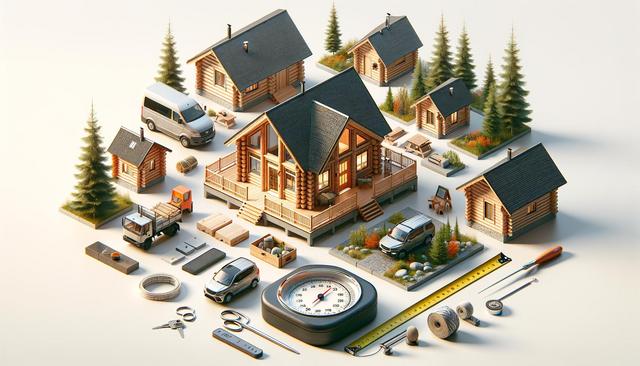Understanding the Appeal of Prefab Log Cabins
Prefab log cabins have gained popularity for their blend of charm, efficiency, and affordability. Unlike traditional log homes that require extensive on-site construction, these cabins are pre-manufactured in a factory setting and then assembled on location. This method shortens build times and often reduces costs, making them an attractive option for vacation homes, backyard offices, or even permanent residences. Prefab construction also ensures greater quality control, as materials are assembled in a controlled environment, reducing delays caused by weather or site complications.
One of the key attractions is the versatility in design. Whether you prefer a compact one-room layout or a multi-bedroom retreat, prefab log cabins can be customized to fit various needs. This flexibility makes them suitable for a range of uses, from weekend getaways to year-round living. Moreover, many manufacturers offer environmentally friendly options, using sustainably sourced wood and energy-efficient features, which appeals to those looking to reduce their ecological footprint.
Exploring Different Style Options
When it comes to style, prefab log cabins offer a surprising variety. The traditional log cabin with its rustic appearance remains a favorite, but modern interpretations are becoming increasingly popular. These newer designs incorporate contemporary elements such as large windows, open floor plans, and minimalist interiors, while still retaining the warmth of natural wood.
Some common styles include:
- Classic Log Cabin: Characterized by rounded logs and a cozy, traditional look.
- Modern Rustic: Combines clean architectural lines with natural materials.
- A-Frame Cabins: Easily recognizable by their steeply angled rooflines, ideal for snowy climates.
- Cottage Style: Smaller in size, with quaint designs perfect for guest houses or studios.
Choosing the right style depends on your intended use, aesthetic preferences, and the environment where the cabin will be located. For example, an A-frame may be better suited for mountainous regions, while a cottage style might be ideal for a garden or lakeside setting.
Breaking Down the Costs
One of the most important factors in choosing a prefab log cabin is the cost. Prices can vary significantly depending on size, materials, customization, and location. On average, a small, basic prefab cabin might start at around $20,000, while larger, more elaborate models can exceed $100,000. It’s essential to understand what is included in the price—some packages may cover only the shell of the cabin, while others include interior finishes, plumbing, and electrical systems.
Additional costs to consider include:
- Site Preparation: Clearing land, laying a foundation, and ensuring utilities are accessible.
- Transportation: Delivery charges for transporting the prefab components to your site.
- Assembly: Labor costs for putting the cabin together on location.
- Permits and Inspections: Local regulations may require approvals that come with extra fees.
Budget-conscious buyers should also factor in long-term maintenance costs. While log cabins are durable, they do require upkeep such as sealing, staining, and inspecting for pests or moisture issues. Understanding these costs upfront helps in making an informed decision.
What to Look for in a Quality Prefab Log Cabin
Not all prefab log cabins are created equal, which is why it’s important to know what to look for before making a purchase. The quality of materials is a major consideration—opt for cabins made from kiln-dried, sustainably sourced wood, which offers better resistance to warping and decay. Pay attention to the joinery and sealing techniques used, as these affect both the durability and energy efficiency of the structure.
Reputable suppliers often provide detailed specifications, warranties, and customer support. Before committing, ask for:
- Certifications: Ensure the cabin meets local building codes and industry standards.
- Customization Options: The ability to modify floor plans or finishes to suit your preferences.
- Customer Reviews: Feedback from previous buyers can offer insights into quality and service.
- After-Sales Support: Assistance with assembly, maintenance, or repairs if needed.
Visiting a showroom or model cabin, if possible, allows you to experience the space firsthand. This can help in assessing the build quality and visualizing how the cabin will fit your needs.
Preparing for Installation and Long-Term Use
Once you’ve chosen your prefab log cabin, preparation is key to a smooth installation and enjoyable long-term use. Start with a site assessment to determine the ideal location, considering factors like drainage, sun exposure, and accessibility. You’ll also need to check zoning laws and building codes in your area, as they can influence the size and type of structure allowed.
During installation, coordination between the delivery team and assembly crew is critical. Ensure the foundation is ready before the prefab components arrive to avoid delays. After the cabin is assembled, a final inspection may be required to ensure compliance with local regulations.
To ensure longevity and comfort, consider adding:
- Insulation: Enhances energy efficiency and makes the cabin usable year-round.
- Heating and Cooling Options: Depending on your climate, options like wood stoves or mini-split systems may be appropriate.
- Security Systems: Particularly important for remote locations or seasonal use.
- Landscaping: Helps the cabin blend with its surroundings and manage water runoff.
Regular maintenance, including sealing the logs and inspecting for wear, will keep your cabin looking great and functioning well for years to come. Establishing a maintenance schedule can help catch small issues before they become major problems.
Final Thoughts: Making an Informed Choice
Prefab log cabins offer a unique combination of rustic charm and modern convenience. Whether you’re seeking a weekend retreat, a home office, or a full-time residence, there’s likely a style and configuration that fits your vision and budget. By carefully considering factors like style, cost, quality, and site preparation, you can make a well-informed choice that meets both your immediate needs and long-term goals.
As with any major investment, take your time to research and compare options. Engage with reputable suppliers, ask detailed questions, and don’t rush the decision-making process. With thoughtful planning, your prefab log cabin can become a lasting and enjoyable part of your lifestyle.






